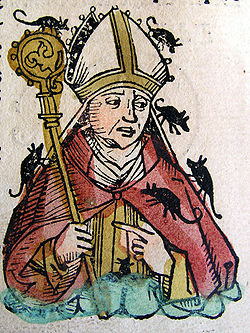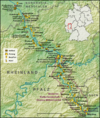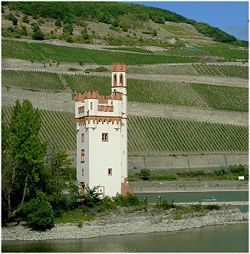- Mouse Tower
-
 Hatto, Archbishop of Mainz. From the Nuremberg Chronicle (1493). Hatto is depicted being eaten alive by mice, as described in the Mouse Tower legend.
Hatto, Archbishop of Mainz. From the Nuremberg Chronicle (1493). Hatto is depicted being eaten alive by mice, as described in the Mouse Tower legend.
The Mouse Tower (Mäuseturm) is a stone tower on a small island in the Rhine, outside Bingen am Rhein, Germany. The Romans were the first to build a structure on this site. It later became part of Franconia, and it fell and had to be rebuilt many times.
Hatto II, the Archbishop of Mainz, restored the tower in 968. The story of how it came to be called the "Mouse Tower" comes from a folk tale. This popular legend goes as follows: Hatto II was a cruel ruler who oppressed and exploited the peasants in his domain. He used the tower as a platform for crossbowmen and demanded tribute from passing ships, shooting their crews if they did not comply. During a famine in 974 the poor people were without food, and Hatto, having all the grain stored up in his barns, used his monopoly to sell it at such a high price that most could not afford any.
The peasants were getting angry and organizing to rebel, so Hatto devised a cruel trick. He promised to feed the hungry people and told them to go to an empty barn and wait for him to come with food. The peasants were overjoyed and praised Hatto heartily, and all of them journeyed to the barn to await his coming. When he showed up with his servants, he ordered the barn's doors shut and locked, then set the barn on fire and burned the peasants to death, derisively commenting on their death cries with the words "Hear the mice squeak!" (This quote exists in several slight variations.)
When Hatto retired to his castle, he was instantly besieged by an army of mice. He fled the swarm and took a boat across the river to his tower, hoping that the mice could not swim. The mice followed him and rushed into the river by the thousands. Many of them drowned, but even more crawled onto the island. There, they ate through the tower's doors and crawled up to the top floor, where they found Hatto and ate him alive.
The "Mouse Tower" story about a cruel ruler has been told about numerous rulers, but this is the most famous version. An allusion to this tale can be found in the poem "The Children's Hour" by Henry Wadsworth Longfellow:
- They almost devour me with kisses,
- Their arms about me entwine,
- Till I think of the Bishop of Bingen
- In his Mouse-Tower on the Rhine!
In 1298 the structure became an official customs collection tower. It was destroyed by a French army in 1689, then rebuilt in 1855 as a Prussian signal tower.
See also
- Popiel, for a similar legend about a Polish medieval duke.
- Wiki source on Mouse tower legends
Castles, Fortresses and Palaces in Germany - The Middle Rhine Valley (North to South) Explanation of location 
Lower Middle Rhine Valley Upper Middle Rhine Valley Stolzenfels Castle · Lahneck Castle · Marksburg · Burg Sterrenberg · Burg Liebenstein · Maus (Mouse) Castle · Rheinfels Castle · Katz (Cat) Castle · Schönburg (Rhein) · Gutenfels Castle · Pfalzgrafenstein Castle · Stahleck Castle · Burg Fürstenberg · Ruine Nollig · Heimburg in Niederheimbach · Burg Sooneck · Reichenstein Castle · Rheinstein Castle · Mäuseturm · Ehrenfels Castle · Klopp Castle · Boosenburg · BrömserburgCategories:- Castles in Rhineland-Palatinate
- Buildings and structures in Rhineland-Palatinate
- Landmarks in Germany
- German folklore
Wikimedia Foundation. 2010.

